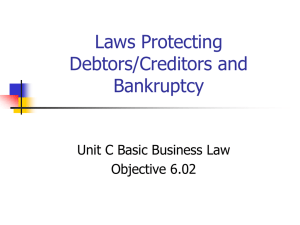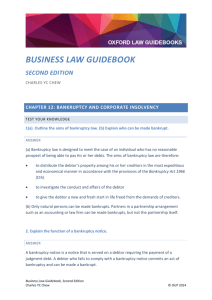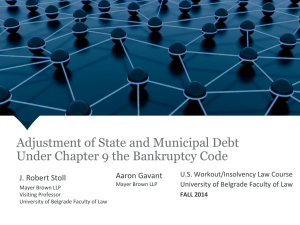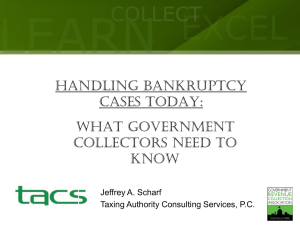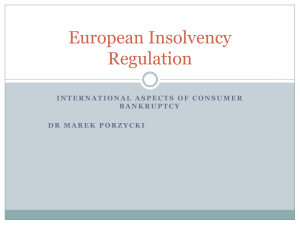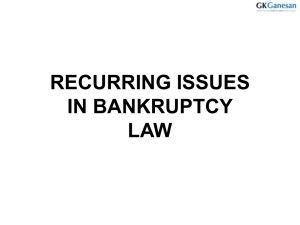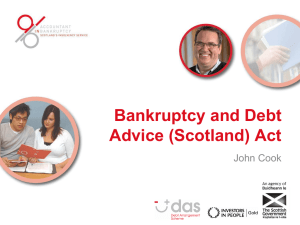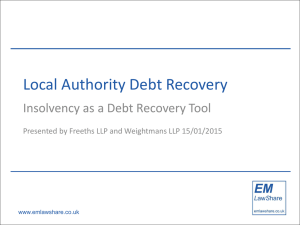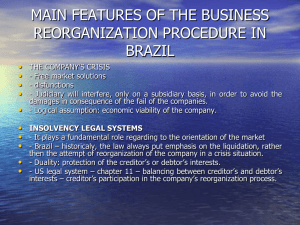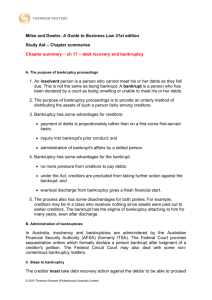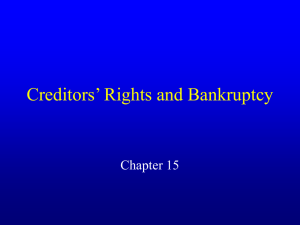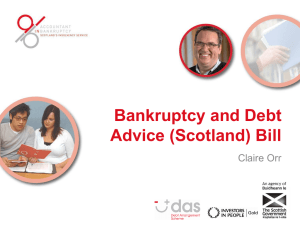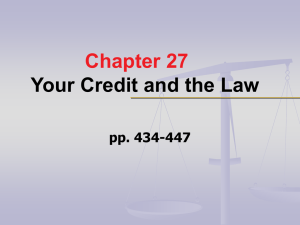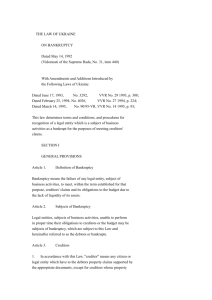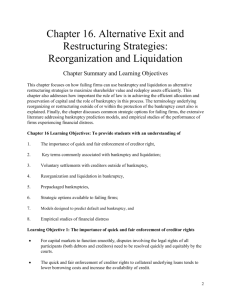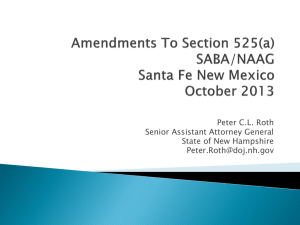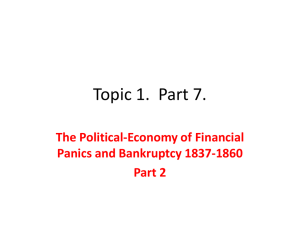Bankruptcy Law in Ireland: Its limitations and the need for
advertisement
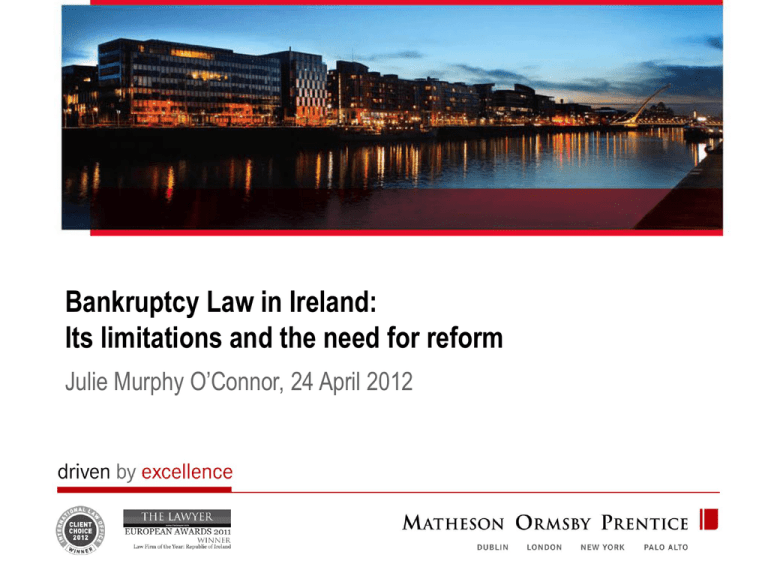
Bankruptcy Law in Ireland: Its limitations and the need for reform Julie Murphy O’Connor, 24 April 2012 Economic climate Credit crunch Company insolvencies have increased – personal guarantee liabilities - increase in director restriction applications Judgments in Ireland have increased – rise in debtrelated litigation Rise in unemployment, fall in average income, fall in house prices and negative equity Bankruptcy is now an option being seriously considered by not just creditors, but debtors themselves Bankruptcy Individuals only Collection and realisation of assets for distribution pro rata amongst creditors Secured debts fall outside the process Relief / benefit – means of freeing a debtor from the balance of their debts when they are unable to pay them in full – fresh start Governed in Ireland by the Bankruptcy Act 1988 (as amended by the EU Insolvency Regulation (EC no 1346/2000) and Civil Law (Miscellaneous Provisions) Act 2011) Context – Court driven process Bankruptcy – asset realisation and distribution to creditors By Court Order On application of creditor or debtor Official Assignee Trustee Debt settlement/arrangement – current options Formal – court supervised scheme of arrangement Composition post adjudication - also requires court approval Informal composition with creditors – requires trust/goodwill -no obligation on creditors to accept – no protection from enforcement Informal trustee arrangement – requires trust/goodwill - no obligation on creditors to accept – no protection from enforcement Consequences of adjudication of bankruptcy All property belonging to the bankrupt (including the family home) automatically vests (with certain exceptions) with the Official Assignee for the benefit of his/her creditors Court approval required for sale of the family home – discretion to postpone sale All property (except certain payments in respect of personal injury or loss) acquired by the bankrupt after the adjudication vests in the Official Assignee, if and when he claims it Consequences of adjudication (ctd) salary is liable to be attached in favour of the Official Assignee cannot hold elected office cannot act as a company director without leave of the Court cannot act as a solicitor, auctioneer, stockbroker, liquidator, receiver, trustee difficulties in operating a bank account – cannot borrow or obtain credit for more than €640 without disclosure to financial institution of bankruptcy (misconception that a bankrupt cannot hold a bank account) Discharge of bankrupt Court will order discharge where Expenses, fees and costs of bankruptcy defrayed, and Preferential debts and all creditors paid in full. or Expenses, fees and costs of bankruptcy defrayed, and Preferential debts paid in full, and where all creditors consent. Discharge (ctd) Court has discretion to order discharge where bankrupt has disclosed all after-acquired property, and court considers it “reasonable and proper” in the circumstances, and creditors paid at least 50c in € by official assignee, or creditors paid at least 50c in € by OA + bankrupt + his friends, or bankruptcy in existence for more than 5 years (reduced from 12 years pursuant to the Civil Law (Miscellaneous Provisions) Act 2011 – effective from 10 October 2011) Discharge (ctd) Civil Law (Miscellaneous Provisions) Act 2011 provides, for the first time, for automatic discharge of bankruptcies on the 12th anniversary of the bankruptcy adjudication order. Before this amendment, bankruptcy was potentially never-ending! Court arrangement (s87 – s109 of the 1988 Act) Debtor petitions to the High Court for protection so that the debtor can put together a court supervised arrangement for consideration with his creditors Court grants protection for the debtor and his assets and directs “preliminary meeting” with creditors Arranging debtor files statement of affairs. OA may undertake proof of debt process. “Preliminary meeting” with creditors at which the debtor presents a statement of assets and liabilities. The debtor must be present in person and keep a minute of the proceedings – all creditors to be notified of meeting. Debtor outlines proposals he intends to make. Court arrangement (ctd) The debtor’s proposal must include a scheme for making a compromise payment to each of the debtor’s creditors (Order 76, Rule 1, Rules of the Superior Courts). Preferential creditors must be paid in full. A “private sitting” before the courts is then scheduled at which the debtor’s proposal for an arrangement with creditors is presented for their consideration 3/5 of voting creditors, in number and value, must approve the debtor’s proposal in the “private sitting” before it can be considered by the Court for approval Arrangement requires Court approval If approved, binding on all creditors Criticisms of Irish bankruptcy system Victorian punitive approach v European rehabilitative approach Creditor focussed Court involvement – too expensive – rarely used 12 years is longer than most prison sentences for manslaughter Fails to distinguish between those who can’t and those who won’t pay; between financial failure and immorality Wholly inappropriate for dealing with reality of consumer debt Bankruptcy legislation is “crippling” the entrepreneurial classes more than 90 per cent of directors of failed companies have debts associated with the company as a result of personal guarantees No right to a solution for debtors Bankruptcy in the UK –v- Ireland In the UK a bankrupt is automatically discharged after 12 months (unless bankrupt fails to co-operate with the trustee in bankruptcy). Following discharge, the debtor can carry on business free of his previous debts. Individual Voluntary Arrangement (IVA) process in UK – properly regulated; out of court arrangement; if passed it is binding on all creditors; administered by licensed insolvency practitioner. Debt Relief Orders (DRO) in UK – unsecured qualifying debts< £15,000; gross assets < £300; disposable income < £50 per month. Statistics In 2009 there were over 130,000 personal insolvencies in England, Scotland and Wales (includes non judicial arrangements), over 135,000 in 2010 and almost 140,000 in 2011. There were 1200 personal insolvencies in Northern Ireland in 2010, and 2,803 in 2011 (includes bankruptcy orders, DRO's and IVA's). There were 8 bankruptcies in Ireland in 2008, 17 in 2009, 29 in 2010 and 33 in 2011. There was 1 scheme of arrangement in 2008, 7 in 2009, 10 in 2010 and 4 in 2011. Although number of bankruptcies only slightly increased, the amount of money involved in each case is continuing to increase dramatically. Impact of reduction of period for discharge? Debtor remains a bankrupt until discharged by the court. Bankrupt may be discharged after 5 years by the court, or will be discharged automatically after 12 years. After discharge, the debtor can carry on business without stigma of bankruptcy. Not short enough a period for it to matter in practice? Preference will still be to forum shop? Forum shopping Are there advantages to debtor opening bankruptcy proceedings in another EU Member State? Yes! On what basis will another EU Member State have jurisdiction to open bankruptcy proceedings in respect of an Irish national/domiciled individual? If debtor can establish to a local court that his COMI is in that other Member State as at the date, the issue is decided by that court. What is the scope for an Irish court refusing to recognise bankruptcy proceedings opened in another EU Member State? Very limited. Fact that Irish court may have reached a different conclusion on COMI is not basis for refusal to recognise decision of other court to open main proceedings. Reform Law Reform Commission – Interim Report 2010 Reform should address: introduction of legally binding, non-judicial debt settlement systems power to compel participation of creditors who unreasonably refuse a settlement offer a legal right to a solution for over-indebted individuals relief, rehabilitation and a fresh/earned start for the overindebted balance and proportionality both mortgage and non-mortgage debt Reform (ctd) Proposed Heads of Personal Insolvency Bill In addition to the current bankruptcy regime, 3 new nonjudicial debt settlement systems for individuals are proposed: Debt relief certificate unsecured qualifying debts <€20,000 Debt settlement arrangement unsecured qualifying debts >€20,001 Personal insolvency arrangement secured and unsecured debts €20,001 - €3m (max) Reform (ctd) Establishment of an Insolvency Service (body corporate staffed by civil servants) to oversee new non-judicial debt settlement systems Proposed amendments to current bankruptcy regime: minimum debt threshold of €20,001 for creditor petition; reduction in period for automatic discharge from 12 years to 3 years (but court can order debtor to continue to make payments to creditors for further 5 years after discharge); can delay discharge for up to 8 years where noncooperation / dishonest behaviour by debtor. Timing Heads of Personal Insolvency Bill published on 25 January 2012. Referred to Joint Committee on Justice, Defence and Equality on 26 January 2012. 10 written submissions received. Public hearing held on 15 February 2012 to discuss issues of concern of those who made submissions. Report of Joint Committee published on 6 March 2012. Initially planned to publish Bill on 30 April 2012 (IMF/EU requirements). Seems now that Bill will be introduced formally to Houses of the Oireachtas before Summer recess. Likely to be some time before Bill eventually becomes law due to complexities involved, including constitutional issues and the requirement to set up the Insolvency Service, etc. Contact Details Julie Murphy-O’Connor Matheson Ormsby Prentice 70 Sir John Rogerson's Quay Dublin 2 D: + 353 1 232 2192 T: + 353 1 232 2000 F:+ 353 1 232 3333 E: julie.murphy-oconnor@mop.ie W: www.mop.ie

